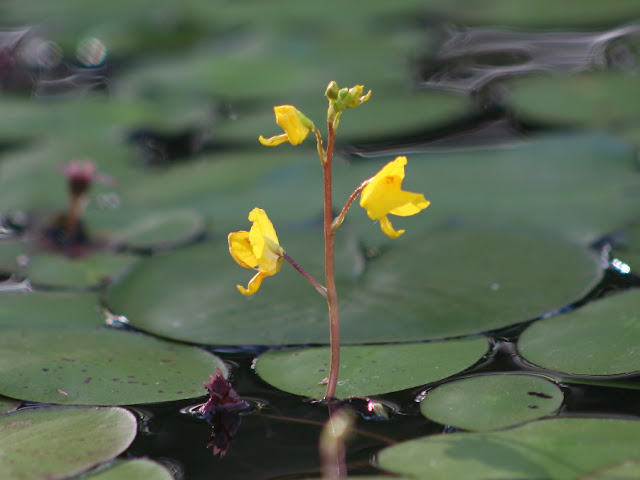 |
| Evening Primrose (Oenothera biennis) |
It is an Evening Primrose, so named because it blooms in the evening, greeting the owner with a bright good morning welcome. The flowers are supposed to close up by noon, but ours seems to want to enjoy much of the afternoon as well.
This primrose is biennal, meaning it has a two year cycle, producing flowers only in the second year, which is interesting because although we remember seeing a plant like this last year, it seems unlikely it would have survived the summer appearing to be only a weed. But perhaps we watched it long enough to mature sufficiently, and only cut if off rather than pulling it up. Anyway, it's a pretty plant, and being biennial, I'm saddened it won't come back next year. But if any of its seeds take root, we'll know to let them grow for a couple of years.
Looking closely at the plant to identify it, I noticed it was home to several different forms of life. Did you notice the little green bug sneaking over the blossom in the the previous pictures?
 |
| A katydid? |
I think it's a katydid. It doesn't have wings, but the nymphs hatch without wings; thier wings appear only after their final molt.
There was also a small brown beetle crawling around on the stem.
 |
| An unknown beetle |
But the best find was this pretty primrose moth.
 |
| Primrose moth (genus Schinia) |
At first I thought it was a rosy maple moth, but learned otherwise after looking closely at the color pattern. It's another new species for me, and its name certainly makes sense considering the plant it was calling home.
It's always fun to find cool insects and spiders hanging out in Linda's flowers!
I did some boundary monitoring on the Harris Conservation Easements with Leah from the Lakes Region Conservation Trust this week which included monitoring from both land and sea. In shallow water along the protected shorelines we found these pretty yellow flowers blooming (I guess yellow is the color of the week):
 |
| Floating Bladderwort (Utricularia radiata) |
This is the flower of the Floating Bladderwort, I think. I'll repeat that I'm not an expert on these matters.
 |
Bladderworts don't have a root, they just float along in the water with a stem that drags down on the bottom of the lake. The coolest aspect of bladderworts is that they are carnivorous. Their underwater bladders are their "mouths". The plant creates a vacuum in its bladders by pumping water out of them. When the hairs on a bladder detect its prey, the plant opens the bladder, sucking in water, and its victim along with it. Here's a description of the process from The Native Plant Trust:
"Like other bladderworts, greater bladderwort is carnivorous, trapping small organisms in its tiny bladders. The trap door operates at speeds that rank among the fastest plant movements known. Triggered by protruding hairs on the door, trap bladders open in about 0.5 milliseconds, sucking the animal in, and closing in about 2.5 milliseconds. This comes to about three thousand feet per second, almost three times the speed of sound."
And yes, bladderworts eat mosquito larvae, so they are our friends! Easement monitoring can be quite educational - thanks for the trip Leah, and for this picture:
 |
| Monitoring Conservation Easements is a highly strenuous job. |
Speaking of the Harris Conservation Easement, that's where our successful loon nest was this year, and both of their chicks are fine, being well attended to by their parents, and learning to fish by watching them. Here's a link to a video Ron Naso captured of the chicks and the parents fishing. Look carefully - the best part is when you can see one of parents flashing by under the water chasing a fish - it happens at 43 seconds into the video. It's amazing how fast they can swim under water.
There has been a lot of loon drama in Marion Cove this week, with three loons in regular confrontation - lots of circle dancing and lots of wing-rowing and vocalizing as they chase each other around.
 |
| "Get out of my cove!" |
It may be the rogue loon we've had the past several years ("Solo") claiming ownership of the cove, while the long-resident (banded) pair still feels they have fishing rights to the waters. At any rate, it seems to be keeping them all occupied and staying away from the new family, which is a good thing.
I'll end this entry with a great storm cloud building up before one of the late afternoon showers this week.
Just another beautiful moment on New Hampshire's lakes.





Wow those water plants are amazing! Thanks for Writing about them. I also found the info about the wild evening primrose very interesting because we have had a strange weed in our gardens. It looks a lot like yours. However we have been quickly pulling them up. Now I think we will leave them to grow and see what we get!
ReplyDeleteLet me know what you find!
Delete